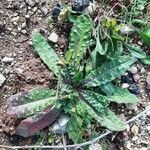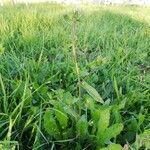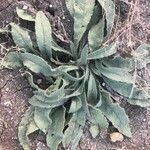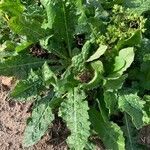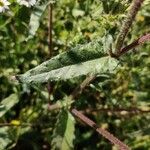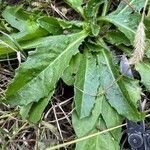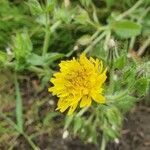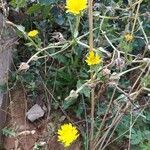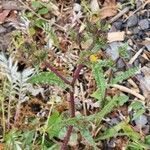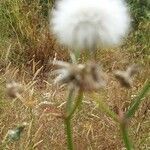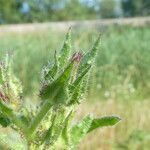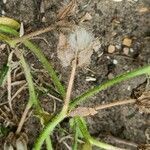Annual or perennial herb, up to 1 m high; hispid; with milky latex. Leaves alternate; blade of basal and lower stem leaves narrowly obovate, narrowed to petiole-like base, margins irregularly dentate; blade of upper leaves narrowly ovate to oblong, sessile, clasping, sometimes decurrent on stem. Heads ligulate, on short peduncles arranged in irregular corymb. Involucral bracts: outer bracts large, ovate-cordate; inner bracts linear to very narrowly ovate, apex long subulate. Receptacle epaleate. Flowers: yellow; Jan., May. Fruit with cypsela of 2 kinds: the outer hairy, with short beak, embraced by involucral bracts; the inner glabrous, wrinkled, long-beaked. Pappus of outer cypsela reduced bristles, of inner cypsela plumose bristles.
Annual to perennial, 25–200 cm high. Indumentum of sparse to dense stiff hairs; anchor hairs mainly 2-and 4-hooked, sometimes with raised base. Capitula few to numerous, 8–19 mm long, 9–13 mm wide; outer involucral bracts 5, upright to spreading, 8–21 mm long, 4–11 mm wide; innermost bracts 8–12, upright, 5–12 mm long, 1–3 mm wide; spur setose, 2–9 mm long. Ligules yellow. Achenes heteromorphic; marginal achenes curved, white, pilose, with body 2.9–3.8 mm long, 0.6–1.4 mm diam.; central achenes brown, glabrous, ribbed, with body 2.4–3.9 mm long, 0.8–1.1 mm diam., rostrum slightly shorter to up to 1.5 times longer than body. Pappus of central achenes 5.9–7.1 mm long; pappus of marginal achenes shorter.
Hispid annual or perennial herb, up to 1 m high, with milky latex. Leaves alternate, radical and lower cauline leaves oblanceolate, narrowed to petiole-like base, irregularly toothed, upper leaves lanceolate to oblong, sessile, clasping, sometimes decurrent on stem. Capitula ligulate, on short peduncles arranged in irregular corymb; outer involucral bracts large, ovate-cordate; inner linear-lanceolate with long subulate apex. Florets yellow. Flowering time Nov.-Feb. (May, Aug.). Pappus of outer florets of reduced bristles, of inner florets of plumose bristles. Cypselae of 2 kinds: outer hairy, with short beak, embraced by involucral bracts, inner glabrous, wrinkled, long-beaked.
A herb which grows over 1 or 2 years. It has spreading stems and irregular branching. The plant is covered with bristly hairs. These are fattened at their bases. There are hooked prickles at the tips of the leaves. The lower leaves are sword shaped and can have a few teeth. They narrow into the leaf stalk. The upper leaves are smaller and do not have leaf stalks. They clasp the stem at the base. The flower heads often occur singly. The flowers are yellow.
Hispid annual or perennial herb, up to 1 m high. Radical and lower stem leaves oblanceolate, narrowed to petiole-like base, irregularly toothed; upper leaves lanceolate to oblong, sessile, clasping. Outer bracts large, ovate-cordate. Achenes long-beaked. Flowers yellow; December to March and in June.
Leaf blades 50–150(–250) × 10–50(–80+) mm. Peduncles 1–5+ cm, bristly hispid. Calyculi: bracts 9–15+ × 3–5+ mm, margins and tips bristly-ciliate. Phyllaries often sigmoid in fruit, abaxial faces and tips bristly. Cypselae: bodies 2.5–3 mm, beaks 2.5–5 mm; pappi 4–7 mm. 2n = 10.
